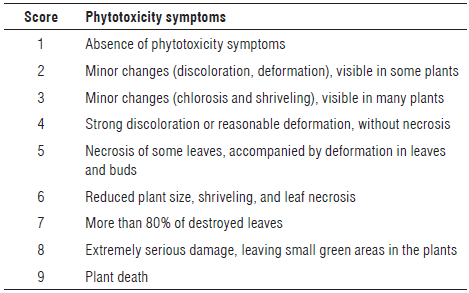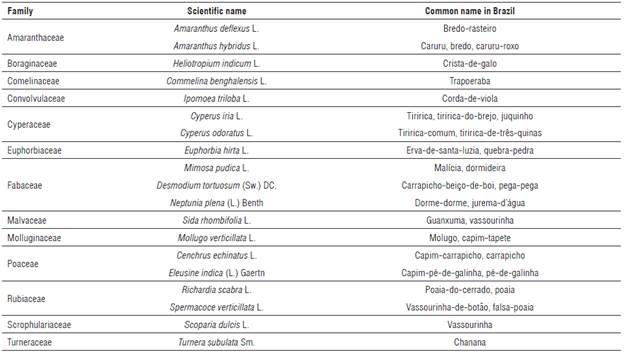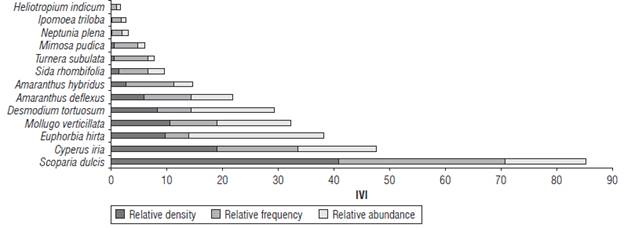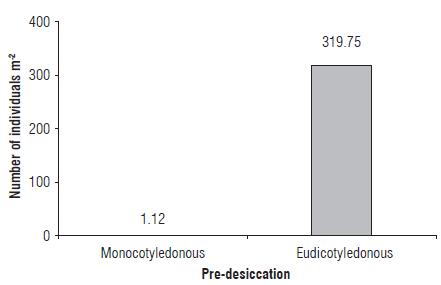Introduction
The soybean (Glycine max (L.) Merrill) is one of the most important oilseed crops in the world. Brazil has a relevant role in this scenario, with a record harvest in 2019/2020, with production estimated at 120.4 million t. This amount was 4.7% higher than that obtained in the 2018/2019 harvest and 0.9% higher than the last record of 119.3 million t reached in the 2017/18 harvest (CONAB, 2020).
Soybeans were introduced in the 1970s in the southern mesoregion of the state of Maranhão. At the beginning of 2000s, the crop was expanded to the Chapadinha microregion and nearby microregions, such as the Baixo Parnaíba Maranhense, Coelho Neto, and recently, to the microregion of Caxias (Conte et al., 2018). Nowadays, Maranhão has a planted area of 1,000,300 ha, with an estimated production of 3,029,9001 (CONAB, 2020), confirming the importance of soybean cultivation in the state.
Despite being a relatively exploited crop with outstanding socio-economic importance, the soybean still presents significant losses in productivity due to several factors, especially weed competition (Gazola et al., 2016). Weeds harm the crop, mainly through competition for water, light, and nutrients; moreover, depending on the cultivar and infestation level, they might hamper the harvesting operation and affect the quality of the grains (EMBRAPA, 2013; Fried et al, 2017).
The phytosociological survey of weeds is a strategic tool used to assess the potential impact of agricultural practices and management systems on the dynamics of weed infestation (Fialho et al., 2011). These studies allow obtaining information on density, frequency, abundance, and index of relative importance of weeds in crops, which are indispensable for efficient chemical control, especially in the pre-emergence phase (Cardoso et al., 2013).
Pre-emergence chemical control uses herbicides with a prolonged half-life in the soil. These products provide control of germinating seeds, a phenological phase in which weed species are more susceptible to the herbicide. The seed bank is reduced in the period before interference (PBI), avoiding initial competition and reducing the number of post-emergence applications and, consequently, the cost of production (Gonçalves et al., 2018). The efficiency of pre-emergence herbicides should be assessed according to the conditions of soil, climate, humidity, and weed species present in the area (Silva et al., 2021).
Some initial studies indicated that weed management predominantly adopted in this mesoregion had probably shown a low level of efficiency as plants resistant to chemical control have been selected, particularly with sequential applications of glyphosate at post-emergence. Hence, the expansion of soybean cultivation in these areas may show several economic, phytosanitary, or environmental problems due to the adoption of inadequate control practices in the medium and long term. Therefore, this study is based on the hypothesis that for the proposal and implementation of integrated weed management (IWM) in the east of Maranhão (Brazil), it is necessary to identify and define adequate control methods of the species present at this site.
In this context, the aim of this study was to analyze the efficiency of different pre-emergence active ingredients on the suppression of the weed seed bank and the growth of soybeans to present strategies for rotating molecules and efficient management of weed competition in commercial soybean farming in the state of Maranhão.
Materials and methods
The study was conducted on a commercial grain farm, located in the municipality of Brejo, in the eastern mesoregion of the state of Maranhão, Brazil (03°42' S, 42°57' W and at an altitude of 90 m a.s.l.) between January and April 2020.
The soil of the experimental area was classified as a typical Distrocoeso Yellow Argisol (Dantas et al., 2014). According to the Koppen classification, the region's climate is tropical wet and dry (Aw), with an average annual temperature above 27°C and average annual rainfall ranging from 1600 to 2000 mm. The rainy season occurs between January and June and the dry season between July and December, with annual relative humidity between 73 and 79% (Passos et al, 2016).
The data of rainfall, maximum and minimum temperatures during the months of the experiment is shown in Figure 1, according to INMET (Portuguese acronym for Brazilian National Institute of Meteorology) (INMET, 2019).
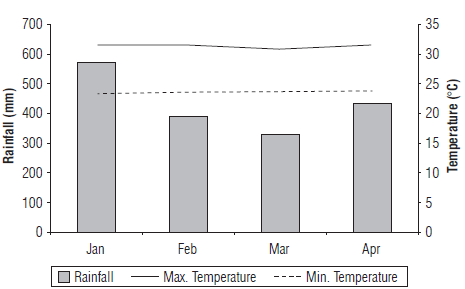
FIGURE 1 Data of rainfall (mm) and minimum and maximum air temperature (°C) registered for the eastern mesoregion of the state of Maranhão between January and April 2020.
The experiment was conducted in a randomized block design, consisting of nine treatments, four replicates, and 40 useful plants per plot. The treatments consisted of control (without pre-emergence application), s-metolachlor (1,200 g of active ingredient (a.i.) ha-1), flumioxazin + imazethapyr (50 + 100 g a.i. ha-1), flumioxazin (50 g a.i. ha-1), imazethapyr (100 g a.i. ha-1), trifluralin (1,112.5 g a.i. ha-1), diclosulam (45 g a.i. ha-1), diclosulam + imazethapyr (30 + 100 g a.i. ha-1) and clomazone + carfentazone-ethyl (720 + 18 g a.i. ha-1). The plot occupied an area of 18 m2 (6 m x 3 m), spaced 2 m apart. For crop evaluation, the three central lines of 1 linear meter of each plot were assessed, leaving a border of marginal lines.
Pre-planting desiccation was carried out 15 d before planting by applying glyphosate (2,477.1 g a.i. ha-1) + 2,4-D (1,476 g a.i. ha-1). Additionally, the seeds were treated with the insecticide thiamethoxam (500 g a.i. L-1), at a dose of 0.002 L kg-1; fungicide (20 g a.i. L-1 metalaxil-M + 150 g a.i. L-1 tiabendazole + 25 g a.i. L-1 fludioxonil), at a dose of 0.002 L kg-1; and the insecticide cyantraniliprole (600 g a.i. L-1), at a dose of 0.0012 L kg-1 of seeds.
The soybean cultivar FTR 3190 IPRO was used. Sowing was carried out on January 28, 2020, with a density of 16.5 seeds per linear meter and spacing of 0.5 m between rows. The treatments were applied 1 d after sowing as suggested by the "plant and apply" method according to the manufacturer recommendations. For the application of the treatments, we used a knapsack sprayer with a bar with six flat fan nozzles spaced 0.5 m apart, with pressure of 207 kPa and a rate of 150 L ha-1.
At 36 d after application (DAA), plant height, number of leaflets, and canopy closure were assessed in 10 plants set at three central lines of each plot. Additionally, the number of plants per linear meter in each evaluated line was estimated. The parameters evaluated were: plant height (cm), by measuring the distance from the ground level up to the last apical bud using a graduated measuring tape; the number of leaflets, by counting the open leaflets; canopy closure (%), defined as the percentage area covered by the foliage, by using a graduated ruler (the half canopy (25 cm) covered by the leaves of each adjacent line was considered as 100% closure); and the number of plants per meter, by counting the number of plants in the rows of each useful plot.
To determine the effects of herbicides on weed flora, three phytosociological surveys were conducted. The first was carried out at pre-planting 5 d before desiccation and the others at 10 DAA and 36 DAA. In the first survey, 49 launches of an inventory square with an area of 1 m2 were carried out in 3 m x 5 m intervals, in the extension of seven sample lines.
In each sampling, weeds were identified with the help of specialized literature (Lorenzi, 2014) and quantified for estimates of phytosociological indices. The other surveys (10 and 36 DAA) were performed within the experimental plots, in areas of 4 m2, pre-defined and monitored throughout the study.
Based on this information, the phytosociological indices were estimated: density = total number of individuals per species/unit of area (m2); relative density = density of the species x 100/total density of all species; frequency = number of squares containing the species/total number of squares; relative frequency = species frequency x 100/total species frequency; abundance = total number of individuals per species/total number of squares that contain the species; relative abundance = species abundance x 100/total abundance of all species; importance value index (IVI) = relative frequency + relative density + relative abundance. After species identification, the occurrence of individuals by class (monocots and eudicots) for each treatment was quantified.
In this study, the phytotoxic effects of herbicides on soybean cultivation were analyzed. The analysis was conducted at 10, 17, 21, and 36 DAA following the Conceptual Scale Model of the European Weed Research Community (Johannes, 1964); the scores ranged from one for plants that did not show phytotoxicity symptoms to nine for plant death (Tab. 1).
Phytosociological data were analyzed using descriptive statistics. The variables related to soybean growth were subjected to analysis of variance by the F test (P<0.05) and the means compared by the Tukey's test. Additionally, a multidimensional test was applied using the software Statistica® 7.0.
Results and discussion
In the surveys carried out before and after planting, 19 weed species were identified, distributed in 17 genera and 13 botanical families (Tab. 2).
The Fabaceae family had three identified species, followed by Amaranthaceae (2), Cyperaceae (2), and Poaceae (2). The families and species found were similar to those identified by Lopes, Silva, Costa, Oliveira, et al. (2020) when studying the phytosociology of the seed bank in experimental farming located in Chapadinha (MA, Brazil).
In the phytosociological survey carried out in the pre-desiccation period, the species Scoparia dulcís showed the highest importance value index (85.35) (Fig. 2). Such results are similar to those found by Lopes, Silva, Costa, Silva, et al. (2020) in studies on the spatial distribution of the seed bank in an area with a history of soybean crops in Chapadinha.
According to Oliveira and Freitas (2008), the importance value index indicates which species within the weed community has the greatest potential to cause damage to the crop. Thus, the species Scoparia dulcis could be considered the weed with the highest potential, followed by the species Cyperus iria (47.61), Euphorbia hirta (38.21), Mollugo verticillata (32.21), and Desmodium tortuosum (29.28), which demand constant monitoring during the crop cycle and later harvests.
When assessing the class of weeds, it was observed that the highest infestation, estimated as the number of plants per square meter in the pre-desiccation period was by the eudicotyledonous (Fig. 3). According to Rizzardi and Silva (2014), to define adequate suppression tools, it is necessary to have information about the class of weeds existing in a determined location, its distribution, and population.
Takano et al. (2013) recommended pre-planting desiccation with broad-spectrum herbicides or latifolicides, such as glyphosate and 2,4-D, respectively, which is in line with the management employed by the producer in this study. However, Placido et al. (2016) emphasized that it is relevant to rotate the use of mechanisms of action at different stages of chemical weed control. These two molecules must be used in a planned way, especially glyphosate, since their sequential use in high doses has induced the occurrence of resistant genotypes in several countries, including Brazil.
The phytosociological survey conducted at 10 DAA revealed a reduction in the number of infesting species compared to infestation during pre-planting (pre-desiccation). This result confirms the importance of well-planned pre-emergence control and desiccation to obtain a cleaner crop, particularly at the critical growth phase of the crop (Fig. 4).
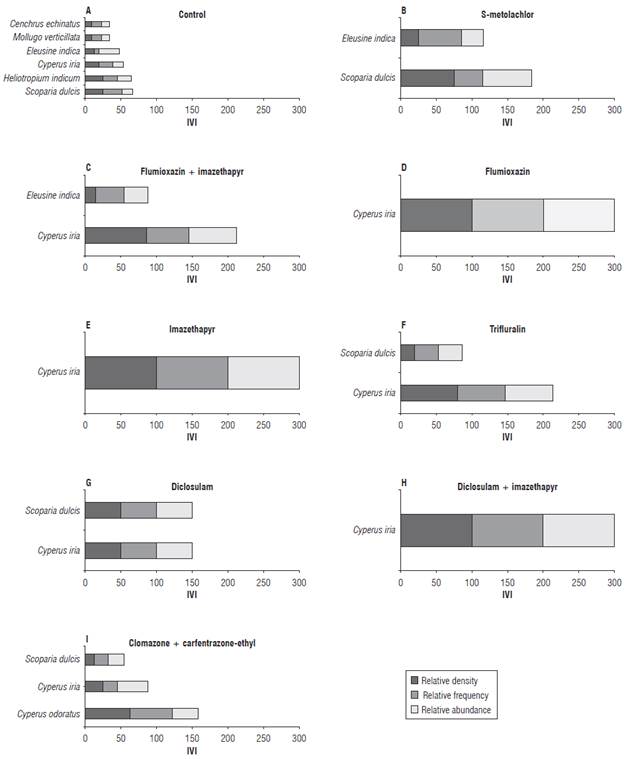
FIGURE 4 Importance value Index (IVI) of weeds In soybean crops, 10 d after application (DAA), under the effect of different pre-emergence molecules: A) control; B) s-metolachlor; C) flumioxazin + imazethapyr; D) flumioxazin; E) imazethapyr; F) trifuralin; G) diclosulam; H) diclosulam + Imazethapyr; I) clomazone + carfentrazone-ethyl.
All pre-emergence treatments significantly reduced the number of weed species compared to the control. Although the whole plot was uniformly desiccated at pre-planting, the plots not treated with pre-emergence herbicides became more vulnerable to weed infestation. Thus, these non-treated plots demanded post-emergence applications to reduce the weed competition effects on soybean cultivation, with imminent risks on productive yield.
Among the identified species, Scoparia dulcis showed the highest IVI in the control (66.30) and treatments with s-metolachlor (184.23) and diclosulam (150). Cyperus iria had high values of IVI in the treatments flumioxazin + imazethapyr (212.38), flumioxazin (300), imazethapyr (300), trifluralin (213.33), and diclosulam + imazethapyr (300), whereas Cyperus odoratus showed similar values for treatment with clomazone + carfentrazone-ethyl (158.21). These results show the capacity of these species to form large seed banks in the soil as well as to adapt to the edaphoclimatic conditions of the studied region, even when subjected to chemical control with different molecules at pre- and post-planting (Lopes, Silva, Costa, Oliveira, et al., 2020).
In the phytosociological survey carried out at 36 DAA, 12 species were examined in the control, mainly Scoparia dulcis (185.68). The finding corroborates the high infestation of this species in the pre-desiccation period (IVI: 85.35), which indicates that the absence of application at pre-emergence, as a complementary practice, can stimulate weed competition at the growth phase of the crop. In this context, Scoparia dulcis was effectively controlled by diclosulam, in accordance with the results obtained by Martins and Christoffoleti (2014) (Fig. 5).
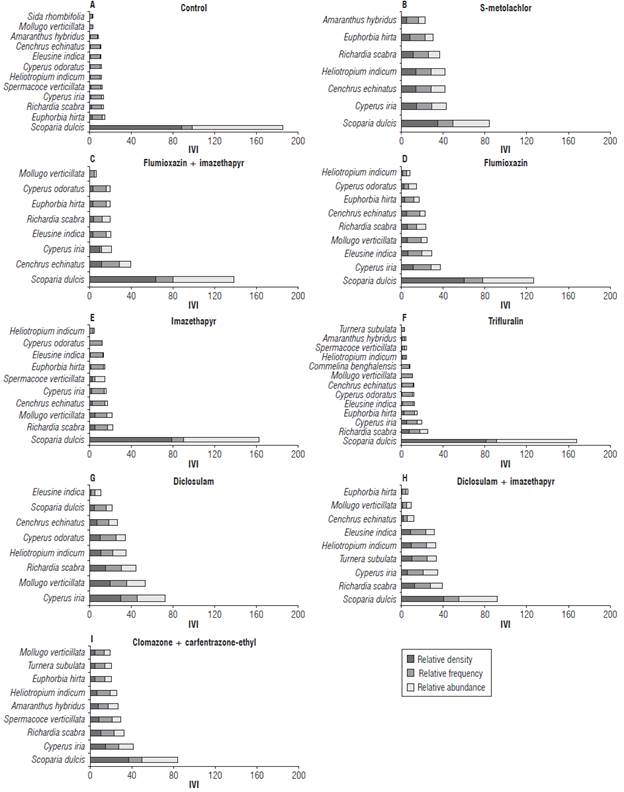
FIGURE 5 Importance value Index (IVI) of weeds In soybean crops 36 d after application (DAA), under the effect of different pre-emergence molecules: A) control; B) s-metolachlor; C) flumioxazin + imazethapyr; D) flumioxazin; E) imazethapyr; F) trifluralin; G) diclosulam; H) diclosulam + Imazethapyr; I) clomazone + carfentrazone-ethyl.
In all pre-emergence treatments, except for trifluralin, there was a reduction in the number of weed species. In treatments using trifluralin, the reductions were observed only in 13 species (Fig. 5F). According to data from the University of Hertfordshire (2020), this herbicide shows a high volatilization capacity at 20°C, which may have decreased its pre-emergent control efficiency under the study conditions (27.7°C), demonstrating the limitations for its use in this phase in the local productive sector.
A reduction in the infestation of mono and eudicotyledonous weeds at 10 and 36 DAA was observed for all treatments compared to the control, which highlights the importance of pre-emergence chemical control as an alternative to pre-planting desiccation (Fig. 6). This result corroborates the findings of Andrade Junior et al. (2018) that demonstrated pre-emergence chemical control as an indispensable tool to obtain control of weed competition in the critical period of prevention of interference and to provide maximum productive potential of the soybean crop.
The pre-emergence herbicides have demonstrated, in their majority, the adequate control of monocots. Similar results were obtained by Alonso et al. (2013), who reported the selective, graminicide, and residual effect of these molecules on soybeans. Thus, these herbicides possibly provided an efficient suppression of the emergence flow of weeds in the critical phase of crop establishment for most of the treatments analyzed.
According to Jadhav et al. (2013), the performance of pre-emergence herbicides may vary depending on diverse factors, such as edaphic and climatic conditions and the species that will be controlled. In this sense, s-metolachlor, which is one of the molecules most used by local producers, did not show the residual and selective efficiency expected concerning the control of monocotyledonous weeds (Fig. 6B).
Different results were found by Machado et al. (2016), who obtained satisfactory control of monocotyledonous weeds up to 46 DAA under the effect of s-metolachlor at a dose of 768 g a.i. ha-1 in Rio Verde (GO, Brazil). This may be due to the conditions mentioned by Jadhav et al. (2013), which affect the behavior of molecules in the soil and in the plant and, therefore, affect their efficiency in suppressing weed competition.
The application of flumioxazin in a mixture with imazethapyr or alone exhibited significant results, being efficient in controlling weed competition but with superior efficiency when applied alone (Fig. 6C-D). This efficiency could be associated with the interactions that occur between the mixed herbicides, which, according to Gazziero (2015), can result in synergistic or antagonistic interactions. In a study conducted by Vidal et al. (2010), an antagonistic effect of imazethapyr was found in a mixture with clomazone and glyphosate.
Imazethapyr applied alone was efficient to control the monocotyledonous infestation up to 36 DAA. There was no effect on eudicotyledonous infestation (Fig. 6E), even though this is an herbicide with a broad spectrum of control (Rodrigues & Almeida, 2011). These results are in line with those of Marchioretto and Magro (2018), who did not find adequate control of imazethapyr on eudicotyledonous weeds in the bean crop for the same tested dose (100 g a.i. ha-1).
Treatments with trifluralin and clomazone + carfentra-zone-ethyl did not show effective control of weed competition at 36 DAA, mainly in eudicots. These treatments exhibited infestations of 205.25 and 154.00 plants per square meter, respectively (Fig. 6F and I), only lower than the control. According to Sofiatti et al. (2012), trifluralin is a selective herbicide indicated for the control of monocots and some small-sized eudicots, a fact that explains the greater control of monocots by this herbicide.
A lower level of eudicotyledonous infestation was observed after the application of clomazone + carfentrazone-ethyl. This result is in line with those obtained by Sanchotene et al. (2017), who tested the effectiveness of pre-emergence herbicide control on the weed competition in the soybean crop. These authors did not obtain effective control of this mixture on eudicotyledonous weeds.
According to Willingham et al. (2008), clomazone is a selective and efficient herbicide used for controlling annual grasses in different crops. When mixed with carfentrazoneethyl, clomazone increases the control spectrum over weed competition. In this study, there was no control effect on the broadleaf weeds, which may be associated with the behavior of the product in the soil and the plant and with the application techniques adopted.
The use of diclosulam alone showed an adequate control of weed competition, mainly of eudicotyledonous weeds up to 36 DAA (Fig. 6G). However, when applied in a mixture with imazethapyr, a reduction in latifolicidal selectivity was observed, which is in line with the study conducted by Vidal et al. (2010) that indicated antagonistic interactions (Fig. 6H).
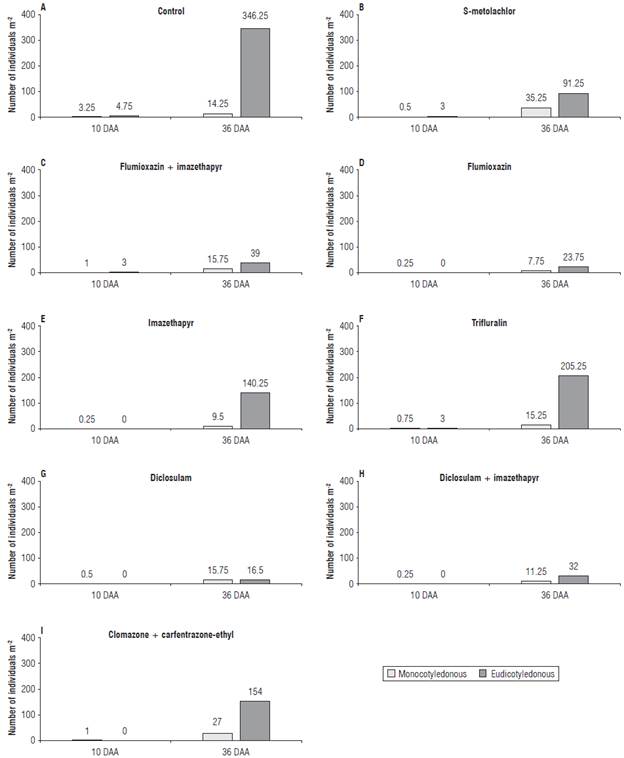
FIGURE 6 Monocotyledonous and eudicotyledonous weed Infestation In a commercial soybean plot at 10 and 36 days after application (DAA), under the effect of different pre-emergence molecules: A) control; B) s-metolachlor; C) flumioxazin + imazethapyr; D) flumioxazin; E) imazethapyr; F) trifluralin; G) diclosulam; H) diclosulam + imazethapyr; I) clomazone + carfentrazone-ethyl.
Regarding the effect of pre-emergence treatments on selectivity in soybean cultivation, there was a significant effect (P<0.05) of treatments on plant height, canopy closure, number of leaflets, and number of plants per linear meter. The plants treated with diclosulam showed the highest plant height (50.00 cm), which was statistically similar to the other pre-emergence treatments, except for s-metolachlor (40.30 cm) (Tab. 3).
According to Santos et al. (2012), s-metolachlor is a nonionizable compound that acts as an inhibitor of cell division of the plant's shoot. The results indicated that the herbicide probably produced an unexpected antagonistic effect on the initial growth of soybean simultaneously with the control of the weed seed bank in the soil.
Regarding canopy closure, the control showed the lowest average (68.26%), with the high weed infestation occurring in this treatment at 10 and 36 DAA (Tab. 3; Fig. 7). According to Carvalho et al. (2010), the intense competition for water, light, and nutrients in the critical phase of the crop can cause a delay in its growth with negative consequences for the canopy closure and suppression of weed competition. Evident losses may occur at the time the post-emergence application is carried out. Thus, pre-emergence control is recommended as an effective practice to complement chemical control at pre-planting (desiccation) and post-planting (post-emergence).
TABLE 3 Effect of pre-emergence treatments on plant height (PH), canopy closure (CC), number of leaflets (NL), and number of plants per linear meter (NPm) at 36 d after application (DAA) in soybean plants.

CV - Coefficient of variation; the means were subjected to the Tukey's test at 5% probability. Equal capital letters indicate the treatments that do not differ between themselves in the column
The effect of flumioxazin on canopy closure and number of leaflets was similar to the control (Tab. 3). According to Gonçalves et al. (2018), flumioxazin is a latifolicidal that acts as an inhibitor of the enzyme protoporphyrinogen oxidase, playing a role in the oxidation of protoporphyrinogen IX to protoporphyrin IX, which are precursors of chlorophyll biosynthesis. In this study, there was likely a phytotoxic effect due to the unexpected synthesis of reactive oxygen species and lipid peroxidation, leading to negative impacts on soybean growth.
In relation to the number of plants per linear meter, the lowest average of plants per linear meter was observed for the mixture flumioxazin + imazethapyr, which indicates a negative effect of this mixture on the germination or initial growth of soybeans (Tab. 3). Corroborating these findings, Drehmer et al. (2015) demonstrated that the spectrum of control of these active ingredients leads to phytotoxicity effects on legumes when mixed or at high doses.
The analysis of the main components of soybean growth showed a significant correlation between canopy closure and number of leaves, considering that the first component accounts for 39.58% of the total variance of the data; that is, as one of these variables decreases, the other one also decreases (Fig. 7).
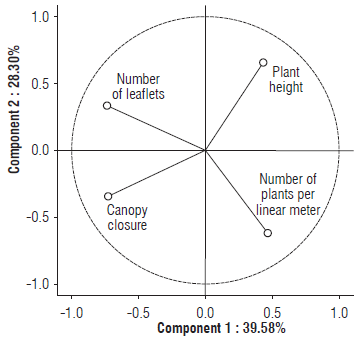
FIGURE 7 Pearson correlation chart for plant height, canopy closure, number of leaflets, and number of plants per linear meter.
These results demonstrate that the components of the crop are linked to the degree of weed interference in such a way that the faster the vegetative growth of the crop, the faster the canopy closure will occur, favoring the suppression of weed competition. According to Perdra et al. (2014), this occurs due to the faster soil shading and the competitive potential of the crop by the limiting factors of the environment, which interferes with the germination and establishment of weeds.
Lopes, Silva, Costa, Silva, et al. (2020) emphasized that suppression is intensified by the use of pre-emergence chemical control, which produces a chemical barrier on the soil surface and delays the development of the dissemination weed bank. This result is well within the findings in this study for most of the pre-emergence herbicides tested in this research.
Regarding the phytotoxic effect of pre-emergence herbicides on soybean cultivation, the highest scores (3) were attributed, at 10 DAA, to treatments s-metolachlor, flumioxazin + imazethapyr, trifluralin, and diclosulam + imazethapyr with some plants at the useful lines analyzed showing slight visible changes (such as chlorosis and shriveling). At 17 DAA, the persistence of this manifestation in the plots treated with flumioxazin + imazethapyr was noted. This may have influenced the smaller number of plants per linear meter and corroborated the hypothesis previously presented (Tab. 4).
TABLE 4 Scores attributed to the visual effects of phytotoxicity of treatments on soybean cultivation at 10, 17, 24, and 36 d after application (DAA).

Sanchotene et al. (2017) observed the phytotoxic effect of flumioxazin + imazethapyr on the soybean crop in two tested doses (50 + 150 and 50 + 104 g a.i. ha-1). The results indicated a low selectivity of that mixture for pre-emergence application on soybean cultivation, although it showed effective control of weed competition.
Clomazone + carfentrazone-ethyl mixture was the pre-emerging treatment that exhibited the highest selectivity on soybean culture. This result was similar to the control (without pre-emergence application) and, therefore, the absence of phytotoxicity at 10, 17, 24, and 36 DAA. These results corroborate those found by Sanchotene et al. (2017) when testing the performance of different pre-emergence herbicides for the control of Euphorbia heterophylla in soybean. Moreover, these authors did not observe expressions of phytotoxicity of this herbicide at a dose of 600 + 15 g a.i. ha-1.
Conclusions
In this study, 19 species of weeds were identified, distributed in 17 genera and 13 botanical families. The species Scoparia dulcis, Richardia scabra, and Cyperus iria exhibited the highest phytosociological indices (123.77, 28.62, and 28.29, respectively), estimated at 36 DAA.
Flumioxazin and diclosulam were the most efficient in suppressing weed competition, with only 15.63 and 16.13 plants m-2. The highest phytotoxicity scores (3.0) were found at 10 DAA, with the application of s-metolachlor, flumioxazin + imazethapyr, trifluralin, and diclosulam + imazethapyr.
The pre-emergent control using flumioxazin and diclo-sulam is recommended for the edaphoclimatic conditions in the Eastern mesoregion of the state of Maranhão, Brazil.













